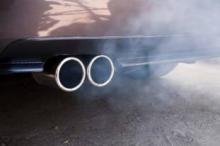ORLANDO – High levels of traffic-exhaust exposure at home were linked with an increased risk for asthma or worsening asthma in adults, according to results from two separate, U.S. studies reported at the annual meeting of the American Academy of Allergy, Asthma, and Immunology.
In one study, the association occurred exclusively among adults who were also obese, said Dr. Tolly Epstein, an allergy and immunology physician at the University of Cincinnati; the second study did not include a body mass index assessment.
Dr. Epstein’s study, which included 104 people aged 65 years or older with asthma, and the second study, which included 20 adults aged 18 or older with asthma who lived in Brooklyn, N.Y., are among the first reported results to link adult asthma with regular exposure to traffic emissions at home.
Results from several prior studies had documented this link in children, but far fewer data exist that show an association in adults, said both Dr. Epstein and Dr. Maria-Anna Vastardi, who reported the Brooklyn results (J. Allergy Clin. Immunol. 2012;129[suppl.]:AB205).
 Photo: Dmytro Panchenko/iStockphoto.com
Photo: Dmytro Panchenko/iStockphoto.com
U.S. Environmental Protection Agency regulations phased in during 2007-2010 began to reduce the fine-particle emissions that seem to have the greatest asthma impact. But full compliance with those regulations won’t happen until buses and trucks that were built before 2007 and are still on U.S. highways reach the end of their commercial lives.
Both researchers also agreed that, for the time being, there is little that asthma patients or susceptible people who live close to highways or other high-traffic roads can do with this knowledge, short of moving further away from heavy traffic.
"New buses don’t produce as much diesel exhaust," noted Dr. Vastardi, an allergy and immunology physician at Downstate Medical Center in Brooklyn. In addition, Environmental Protection Agency regulations phased in during 2007-2010 began to reduce the fine-particle emissions that seem to have the greatest asthma impact. But full compliance with those regulations won’t happen until buses and trucks that were built before 2007 and are still on U.S. highways reach the end of their commercial lives.
Until then, "the best advice is to move away from highways," Dr. Vastardi said in an interview.
The findings from Dr. Epstein’s study suggest that weight loss might also help.
"We don’t know the relationship between obesity, air pollution, and asthma, but results from another study showed the same thing in older adults exposed to ozone," she said. "We know that obesity is a risk factor for poor asthma control in all populations, so losing weight should help."
Another key finding from her study was that the minimum air level of ECAT (elemental carbon attributable to traffic, which is a surrogate marker for diesel-generated particulate exposure) that linked with significantly worse asthma control was 0.39 mcg/m3, strikingly similar to the minimum ECAT exposure level of 0.41 mcg/m3 that prior findings by her Cincinnati associates showed linked with wheezing in 3-year old children (Am. J. Respir. Crit. Care Med. 2009;180:1068-75).
"What’s important is that we now have a level of ECAT exposure that seems to associate with adverse effects" on asthma, Dr. Epstein said in an interview. "It’s something to look at for public health, this level compared with currently accepted ECAT levels."
Her study, "Cincinnati Asthma Severity in Older Adults," included 104 patients from pulmonary and asthma clinics in the Cincinnati area during March 2010-April 2011 who were at least 65 years old. The study excluded patients with chronic obstructive pulmonary disease or heart failure.
Most enrollees had moderate to severe asthma, based on their level of medication
use. Nearly three-quarters were on regular treatment with a long-acting beta agonist as well as an inhaled corticosteroid, and a quarter were on treatment with an inhaled corticosteroid alone. None of the enrolled patients was on a regimen limited to albuterol only. They averaged an FEV1 (forced expiratory volume in 1 second) of 71% prior to treatment with a bronchodilator.
Data on their ECAT exposure came from a series of air samplings made at 27 sites throughout the Cincinnati area during 2001-2006 as part of the Cincinnati Childhood Allergy and Air Pollution Study. This analysis identified 75% of the older asthma patients with a low ECAT exposure at home of 0.38 mcg/m3 or less, and 25% with a high exposure of 0.39 mcg/m3 or greater. During the sampling period, 95% of the patients reported spending an average of 18 hours a day at home.



